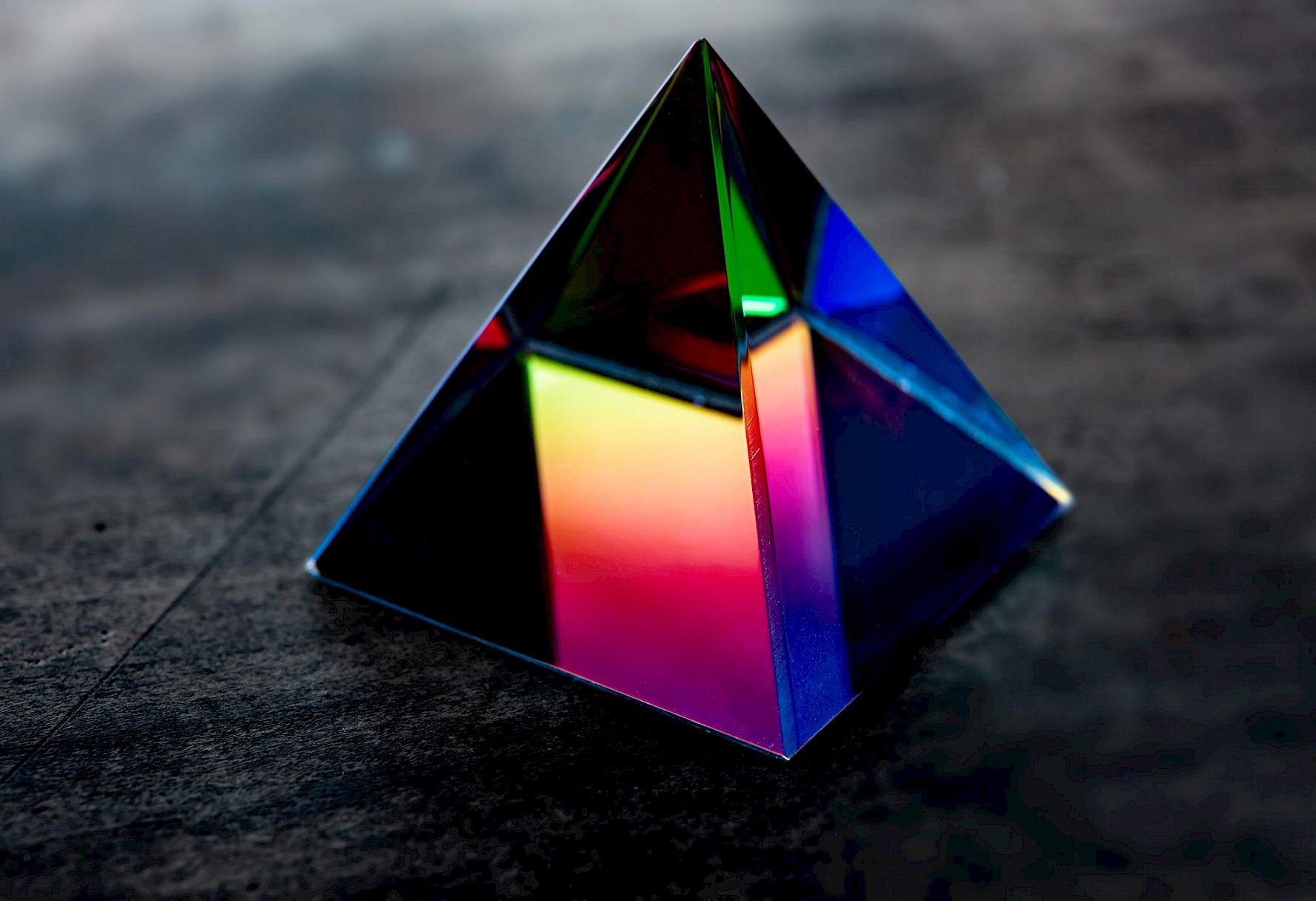Our team are experts in the chemical and physical properties of glass materials. We work with manufacturers to optimise production, troubleshoot issues and support the development of novel glasses.
Colour analysis
We analyse glass colour by UV-visible spectrophotometry to provide manufacturers, brand owners and designers with accurate colour coordinates for
- colour verification
- matching
- development
- benchmarking batch variations
Our services include
- colour analysis, comparison and deviation
- verification against client specifications
- verification of ‘premium’ flint, or ‘extra white’ quality
Analysis provides colour coordinates under the CIE L*a*b* (CIELAB) colour space. Coordinates L*, a* and B* are provided where L* is lightness and components a* and b* are the colour opponents. The benefit of the CIELAB colour space is that it includes all perceivable colours – exceeding that of the common RGB or CMYK spaces – and the colour coordinates are device independent.
The quantification of colour by coordinates allows both limits and tolerances to be set to ensure that specific product branding or performance requirements are met.
Dilatometry and thermal expansion
Dilatometry is a thermo-analytical method for measuring the shrinkage or expansion of materials over a controlled temperature regime. Our dilatometer has the capability to accurately measure the thermal expansion of materials at temperatures between ambient and 1000ºC in air or under an atmosphere.
Matching the thermal expansion behaviour of different materials that are in contact with one another can be important to avoid unwanted stresses and possible cracking. Most materials can be measured by dilatometry, including glasses, ceramics, resins, polymers and metals.
Dilatometry allows the measurement of
- thermal expansion and coefficient of thermal expansion
- sintering temperature and shrinkage steps
- volumetric expansion
- density change
- glass transition temperature
- dilatometric softening point
- phase transitions
We measure against international standards, including
- BS 7030:1988, ISO 7991:1987 (Method for determination of the coefficient of mean linear thermal expansion of glass)
- BS 1902-3.13:1996, ISO 12678-2:1996 (Methods of testing refractory materials. General and textural properties. Measurement of dimensions and external defects of refractory bricks.)
Electrical properties
The electrical properties of glasses and related materials are of great importance, especially in electric-melting, with electric-booster systems or in elevated temperature applications. The data we gather, along with our specialist advice, enables you to modify glass composition, or understand the melting requirements for a desired composition.
Electrical melting of glass utilises the bulk resistivity of the glass, so it’s essential to know what this is and how it varies at elevated temperatures. Different types of glass can have very different resistivities. Changes in composition, particularly in alkali type and content, can strongly influence electrical properties.
We can undertake
- predicted resistivity measurements to offer a quick, inexpensive solution based on literature values for appropriate glasses in our database
- actual measurements of the high-temperature resistivity of glass
Glass density
Our experts determine glass density using either the
- Archimedes method for large or bulk samples
- variable density fluid method for small fragments or samples
This is generally required as a routine quality assessment to check the consistency of density in manufacture. There is no set standard, but each has their own range of acceptable limits, depending on the application.
Light transmission and absorbance
Our analytical team provides a range of UV/Vis spectrophotometry analysis, which includes near-IR, measurements for a range of UV/IR/light transmission, solar and thermal glass properties, including providing transmission, and absorbance profiles for different glass samples.
These measurements are routinely required for
- packaging for food, drinks and pharmaceuticals that must provide protection against ultraviolet light
- optical components
- flat glass for architectural and automotive applications
Liquidus temperature
The liquidus temperature is that above which no crystals can exist and the melt should be homogenous. Prolonged heat treatment of glass can lead to crystallisation if the temperature is not properly controlled.
You may need to determine the liquidus temperature if you’ve experienced crystal formation during changes in production. Or perhaps your fibre glass production process has been interrupted by fibre breakage caused by devitrification in glass.
We measure it using a temperature gradient furnace with glass placed in a platinum or ceramic boat and held for the required time. Test times are tailored to the specific sample and may vary from several hours to several days. The temperature profile throughout the furnace is monitored so that on removal and cooling, the temperature profile across the sample is known.
We observe the sample by polarised-light optical microscopy to determine the liquidus temperature of the glass and identify the primary crystalline phase (if required).
Littleton softening point
The littleton softening point is the temperature at which the log (viscosity) for a glass is 6.6 Pa/s. This is especially important when firing an enamel or frit onto a glass article, and gives an absolute maximum upper temperature limit for processing the glass.
Measurement is conducted using the international standard ASTM C338 for fibre elongation. The temperature of the fibre is increased at a standard rate and elongation measured against time. This test gives confidence for operating limits in downstream manufacturing processes. Comparisons of softening points between glasses can be made without needing full viscosity curves. We then offer expert interpretation and advice to help you understand and use this data.
Refractive index
We provide highly accurate measurements of the refractive index of glass to determine property specification and similarities/differences between glass compositions.
Our team uses GRIM3 (a third-generation measurement system from Foster + Freeman) to assess the refractive index of glass fragments using the oil-immersion method. This system is widely used in the field of forensic science and is of particular use for the comparative analysis of multiple samples. For example, microscopic fragments can be compared with glass from a suspected source item to confirm whether the fragments could have originated from it.
Refractory corrosion and stability
The attack of molten glass on refractory materials is of prime importance to both the glassmaker and refractory manufacturer. Over a period of several years, we have developed what are now regarded as the standard tests for the assessment of refractory corrosion.
Two basic tests have been developed for the investigation of refractory attacks.
Corrosion test
This involves the production of a refractory finger by core drilling and diamond machining the refractory to a specific size. The test piece is suspended in molten glass, either for a specific period or until delineation between samples occurs, then carefully drained before we measure the wear at the flux-line. The test, although comparative in nature, allows us to
- assess of the rate of attack
- observe the reaction below the glass surface
- examine the level of colouration of the glass
- identify the potential for the production of stone in the glass
Bubble potential
This test (performed in conjunction with the above) is used to assess the level of bubble or seed released into the glass when it is in contact with the refractory material. This is especially useful for assessing glass contact materials. A small refractory boat is cut from the sample using diamond machining. This is filled with glass and heated up to melt the glass and allow the two materials to react. The sample is then cooled down and sectioned for examination using optical microscopy.
As well as standard tests performed routinely for refractory suppliers, we can carry out various assessments designed to highlight specific corrosion problems within your technology. Specialist analytical services are also available to further investigate the reaction products of these examinations. This suite of techniques is particularly beneficial for investigating penetration reactions, and for preliminary identification of the phase chances that may occur as a result of glass penetration.
A range of other tests are also available to determine properties such as density, real and apparent porosity, permanent linear change of shape and exudation at temperature. This flexibility of methods enables us to maximise the information gained.
Temperature-viscosity
We can determine the temperature-viscosity relationship of glass, which is essential to establish correct melting and heat treatment regimes in glass manufacture and processing.
Glass articles or fibres must often be melted and formed within tight viscosity ranges, so it is vital to know exact temperature-viscosity relations for different glasses, as these will be affected by composition, melting behaviour, time, temperature and other factors, all of which may impact production.
The temperature-viscosity relationship is directly linked to its chemical composition. Our specialist knowledge allows us to provide direct measurement and predictive modelling of this relationship for a range of glasses.
A standard measurement may include viscosities at temperatures between approximately 800ºC and 1400ºC, although this range can be extended if necessary.
For container glasses, float glasses, and a range of other compositions, we also offer predictive computer modelling of the viscosity-temperature relationship. This is an inexpensive, rapid turnaround service, although in certain circumstances we recommend measurement in conjunction with predictive modelling.
Measuring high temperature viscosity allows a fuller understanding of glass properties. By determining the fixed points for glasses, it is possible to accurately estimate the working range and the relative machine speed of different glass compositions. This service can be offered as a rapid turnaround predictive modelling service.
Thermal and solar properties
When glazing is to be used in applications where energy conservation is important, the thermal transmittance (U-value), light transmission (%), light reflectance and solar factor (g-value) properties of the glass and coatings should be specified.
We carry out testing in accordance with BS EN 410, BS EN 673 and BS EN 12898 as specified within the product conformity standards for most glasses to be used in construction.
We can also measure the argon gas concentration using non-destructive methods on insulating glass units sent to our laboratory. Argon gas is primarily used to reduce heat loss in insulating units and the concentration level has a direct impact on the thermal performance and running costs of a building.
The gas concentration can be compared with the requirements in BS EN 1279 (Long term test method and requirements for gas leakage rate and for gas concentration tolerances). This forms part of our overall product verification service where specified product performance can be compared with delivered product performance in buildings.
Test standards
- BS EN 410 (Glass in building. Determination of luminous and solar characteristics of glazing)
- BS EN 673 (Glass in building. Determination of thermal transmittance (U-value). Calculation method)
- BS EN 12898 (Glass in building. Determination of the emissivity)
- ISO 9050 (Glass in building. Determination of light transmittance, solar direct transmittance, total solar energy transmittance, ultraviolet transmittance and related glazing factors)
- BS ISO 13837 (Road vehicles. Safety glazing materials. Method for the determination of solar transmittance)
- BS EN 1279-3 (Glass in building. Insulating glass units. Long term test method and requirements for gas leakage rate and for gas concentration tolerances)
Glass property measurement leadership and expertise
Our expert team of glass technologists, chemists and analysts specialise in determining a wide range of glass properties – including thermal, optical and electrical characteristics. We can carry out tests to many different international glass standards.


